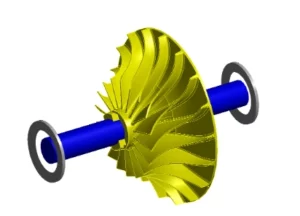Opportunities for applied additive manufacturing in the energy sector: a case study
Before the COVID-19 pandemic shocked the supply chains of various industries across the world, supply chains were organized according to where original equipment manufacturers (OEMs) were located. The US and Europe leveraged their exclusive access to additive manufacturing technology and their expertise on equipment manufacturing as an advantage to drive economic success. While supply chains were dangerously stretched before the pandemic, the impact of COVID-19 and other weighing factors have exacerbated the outcomes, crippling supply chains and leaving businesses vulnerable to challenges in the acquisition of spare parts.
However, the developing world is quickly catching up, with these advanced technologies and the industry know-how existing locally in most regions today. Despite this, supply chains still need to adapt to fully leverage the benefits. Additive manufacturing has presented a unique opportunity for the energy sector, among others, to leverage its offering and the benefits of acquiring parts on demand. Despite this, supply chains still need to adapt to fully leverage the benefits.
Immensa rises to the challenge with advanced additive manufacturing solutions
As the first ISO-certified additive manufacturing company in the Middle East and North Africa (MENA) region, Immensa has assisted a wide range of clients. Read on as we analyze a case study where we tested the performance of an additively manufactured impeller part.
An overview
Together with the progression of the pandemic, rising tensions among international trade coupled with the effects of climate change and disruptive technologies have accelerated the demand for locally manufactured spare parts across various industries around the world. Metal additive manufacturing, particularly in the energy sector, has experienced significant growth since then, with particular quality measures and industry-specific standards being introduced to optimize the production of spare parts as the demand for additive manufacturing continues to increase locally.
The challenge
During the production phase, one of the main challenges encountered in the additive manufacturing of metals is the thermal stress that is present as a result of the welding process. Impeller parts can thus be warped or become detached from the build platform due to these thermal stresses. Thermal stress can also potentially cause minor damage to the printing machine itself. Additionally, in most of the printing production cases of functional parts, the new part’s properties will comply with the original part that was manufactured through a subtractive technology.
The solution
The engineering solution presented by Immensa is to utilize analysis system additive manufacturing (ANSYS) as an engineering process to test the performance of the part prior to the printing phase. By simulating the engineering process, we are able to predict potential issues or failures in the production stage. In doing so, safe and sound decisions can be made
regarding the particular printed parts, support structure requirements and the most feasible printing parameters.
By applying this approach, we are able to prevent potential failures that can result in raw materials wastage, save on costs and the hours spent on machines and manufacturing, and reduce lead times.
Below, we can see what a simulated impeller looks like before it enters the 3D printing phase. As illustrated, the displacement due to the induced thermal stresses is minimal, with the simulation being acceptable and indicating no interruption during printing and the part conforming to required tolerances.
Getting to know Immensa
Immensa is a highly experienced, qualified and certified additive manufacturing and digital warehousing company. Through a global network of advanced manufacturers, we escalate production capabilities while lowering lead times for spare parts acquisition through on-demand additive manufacturing. By scanning and storing designs within our highly secure digital warehouse, we allow parts to be digitally stored and provide access as required while cutting costs on physical warehousing and logistics.
We work together with industry leaders, assessing a client’s inventory and analyzing their physical spare parts to help them gain an understanding of their supply chains and what is required to develop their digital transformation process. Once we have identified the required material and defined the additive manufacturing processes required, we design and digitally store spare parts for access as and when required.
Do you want to learn more about our advanced additive manufacturing and digital warehousing solutions?

